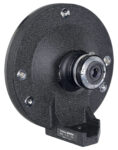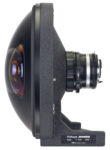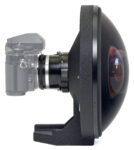Nikon AI-S Fisheye-Nikkor 6mm F/2.8
Fisheye lens • Film era • Discontinued • Collectible
- Announced:
- · March 1982
- Production type:
- · Small-batch production
- Availability:
- ● Sold out
- Country of design:
- · Japan
- Original name:
- · Nikon Fisheye-NIKKOR Auto 1:2.8 f=6mm
- Class:
- · Fast full-frame circular fisheye lens
- · Professional model (Top class)
- System:
- · Nikon F (1959)
Abbreviations
| AI-S | A manual focus lens with automatic maximum aperture indexing and automatic aperture control. Learn more |
| FISHEYE | An ultra-wide angle lens with strong uncorrected barrel distortion and extreme angle of view. |
Model history (3)
| ■Nikon Fisheye-Nikkor Auto 6mm F/2.8 | A | 12 - 9 | 0.25m | -- | 1970 ● | |
| ■Nikon AI Fisheye-Nikkor 6mm F/2.8 | A | 12 - 9 | 0.25m | -- | 1977 ● | |
| ■Nikon AI-S Fisheye-Nikkor 6mm F/2.8 | A | 12 - 9 | 0.25m | -- | 1982 ● | |
Specification
| Optical design: | |
| 35mm full frame | |
| 6mm | |
| F/2.8 | |
| 12 elements in 9 groups | |
| Circular fisheye | |
| Nikon F [46.5mm] | |
| 220° | |
| Diaphragm mechanism: | |
Diaphragm type: | Automatic |
Aperture control: | Aperture ring (Manual settings + Auto Exposure setting) |
| 7 (seven) | |
| Focusing: | |
| 0.25m | |
| <No data> | |
Focusing modes: | Manual focus only |
Manual focus control: | Focusing ring |
| Physical characteristics: | |
| 5200g | |
| ⌀236×160mm | |
| Accessories: | |
| Removable front filters are not accepted | |
| Built-in L1BC, Y48, Y52, O56, R60 (part of the lens optical system) | |
| Not available | |
| Nikon Teleconverter TC-14 → 8.4mm F/3.9 | |
| Nikon Teleconverter TC-14A → 8.4mm F/3.9 | |
| Nikon Teleconverter TC-200 → 12mm F/5.6 | |
| Nikon Teleconverter TC-201 → 12mm F/5.6 |
Sources of data
- Manufacturer's technical data.
- Nikkor lenses booklet (1984).
- Nikon dealer notebook pages.
- Nikon dealer catalogue.
- Nikon Full Line Product Guide (1996-1997) (August 1996).
Manufacturer description #1
Ideal for special effects, the extraordinary picture angle of 220 deg. is 40 deg. wider than standard fisheye lenses. This lens actually sees behind itself! Bright f/2.8 aperture for photographing in dim light or with fast shutter speeds. Close focusing down to 11 inches, through-the-lens viewing and metering. Easy filter interchange; 5 filters are built into a revolving turret inside the lens. Around image is created on the film.
Manufacturer description #2
The Fisheye-Nikkor 6mm f/2.8 lens has the widest picture angle of any lens on the market - an amazing 220 degrees. It records not only everything in front, above, below and to either side of the lens but also sees slightly behind itself. Multilayer coating reduces reflection, thus minimizing flare and ghost images. This results in improved contrast and excellent color rendition. Unlike other fisheye lenses, it fits the camera without any need to lock up the reflex mirror and takes full advantage of the reflex viewing feature of Nikon and Nikkormat cameras. The focusing range extends down to 0.9 foot to permit pinpoint focusing on foreground objects while throwing the back-ground out of focus at large apertures, and the aperture diaphragm of f/2.8 means that the viewfinder image is extra-bright for easy viewing and focusing even in dim light. A set of five filters is built into the lens barrel.
The usual fisheye lens covers a 180° hemisphere and produces a circular image on film. Barrel distortion is considerable, since the circumference of the image circle corresponds to a straight line. The Fisheye-Nikkor 6mm f/2.8 captures an extra 40° of picture angle and records the scene with varying degrees of distortion in the form of a circular image 23mm in diameter. Like other fisheye lenses, the Fisheye-Nikkor 6mm f/2.8 applies the equidistant projection formula (y = Cd) in order to accommodate the extra-wide picture angle within a field of finite size. The zenith angle of any point in the image recorded on film is proportional to its distance from the center of the image. This makes the lens suitable for scientific requirements such as measuring the zenith or azimuth angles of astronomical bodies or recording cloud distribution patterns in the sky. It is also useful in surveying work which requires checking the camera position. And its extra coverage makes possible more accurate measurements of greater detail over the 180° field. The lens is also widely used for creating unique special effects.
A set of five filters is built into the rear end of the lens mount: skylight (L1BC), medium yellow (Y48), deep yellow (Y52), orange (056) and red (R60). These filters are mounted on a revolving turret so they can be moved into place quickly one after another. Turn the knurled filter selector dial on the side of the lens mount until the desired filter designation on the rim of the dial clicks into place. The selector dial should not be set at an intermediate position. The skylight (L1BC) filter is used in either black-and-white or color photography. The others are normally used to subdue the effect of certain colors or to increase image contrast in black-and-white photography. Contrast increases progressively from yellow to orange to red.
Typical characteristics of fisheye lenses
- Extreme angle of view (at least 180° diagonally);
- Circular types (the image circle of the lens is inscribed in the image frame) or diagonal types (cover the entire image frame);
- Usually of equidistant projection type, with the distance from the picture center to any given point always proportional to the angle from the optical axis to that point;
- Huge barrel distortion;
- Short closest focusing distance (0.20 - 0.30m with 35mm full-frame prime lenses);
- Very large depth of field, eliminating the need for autofocus or precise manual focusing;
- Due to the extreme angle of view and convex front element, front filters cannot be used;
- Often equipped with a filter turret with swivel-mounted filters;
- Often come with a small, built-in petal-shaped lens hood.
Notes
- This AI-S lens was designed for Nikon FA, FG, N2000, N6000 AI-S cameras and Nikon F3, EL2, EM, FE, FE2, FE10, FG-20, FM, FM2, FM10, FM3A, Nikkormat FT3 AI cameras. The automatic aperture control will only be available on AI-S cameras.
- AI and AI-S lenses are backward compatible with Nikon F, F2, Nikkormat FS, FT, FT2, FTN, EL, ELW cameras.
- On Nikon digital SLR cameras, the automatic exposure metering with AI and AI-S lenses will not be available on D40, D40X, D60, D70, D70s, D80, D3000-D3500, D5000-D5600 series.
Other fisheye lenses in the Nikon F system
| ■Nikon F mount (14) | |||||||||
| Nippon Kogaku / Nikon Fisheye-Nikkor 6mm F/5.6 | M | 9 - 6 | -- | 1970 ● | |||||
| Nikon Fisheye-Nikkor Auto 6mm F/2.8 | A | 12 - 9 | 0.25m | -- | 1970 ● | ||||
| Nikon AI Fisheye-Nikkor 6mm F/2.8 | A | 12 - 9 | 0.25m | -- | 1977 ● | ||||
| Nippon Kogaku Fisheye-Nikkor 7.5mm F/5.6 | M | 9 - 6 | -- | 1966 ● | |||||
| Nippon Kogaku Fisheye-Nikkor 8mm F/8 | M | 9 - 5 | -- | 1962 ● | |||||
| Nippon Kogaku / Nikon Fisheye-Nikkor Auto 8mm F/2.8 | A | 10 - 8 | 0.30m | -- | 1970 ● | ||||
| Nikon AI Fisheye-Nikkor 8mm F/2.8 | A | 10 - 8 | 0.30m | -- | 1977 ● | ||||
| Nikon AI-S Fisheye-Nikkor 8mm F/2.8 | A | 10 - 8 | 0.30m | -- | 1981 ● | ||||
| Nippon Kogaku / Nikon OP-Fisheye-Nikkor 10mm F/5.6 | M | 9 - 6 | -- | 1968 ● | |||||
| Nikon Fisheye-Nikkor Auto 16mm F/3.5 | A | 8 - 5 | 0.30m | -- | 1973 ● | ||||
| Nikon Fisheye-Nikkor 16mm F/3.5 | A | 8 - 5 | 0.30m | -- | 1975 ● | ||||
| Nikon AI Fisheye-Nikkor 16mm F/3.5 | A | 8 - 5 | 0.30m | -- | 1977 ● | ||||
| Nikon AI Fisheye-Nikkor 16mm F/2.8 | A | 8 - 5 | 0.30m | -- | 1979 ● | ||||
| Nikon AI-S Fisheye-Nikkor 16mm F/2.8 | A | 8 - 5 | 0.30m | -- | 1981 ● | ||||
Lenses with similar focal length
| ■Nikon F mount (4) · APS-C | |||||||||
| 7Artisans 7.5mm F/3.5 Fisheye | M | 11 - 8 | 0.29m | -- | 2023 ● | ||||
| Lensbaby 5.8mm F/3.5 Fisheye SLR | M | 8 - 5 | -- | 2014 ● | |||||
| Sunex 5.6mm F/5.6 Super Fisheye | -- | ? - ? | 1.00m | -- | 2007 ● | ||||
| Kelda 6.5mm F/3.5 Aspherical Fisheye CS | M | 10 - 7 | 0.30m | -- | ● | ||||
| ■Interchangeable mount (1) | |||||||||
| Spiratone 7mm F/5.6 Fisheye [T] akaHanimex 7mm F/5.6 Fish-eye | P | ? - ? | -- | ● | |||||




















